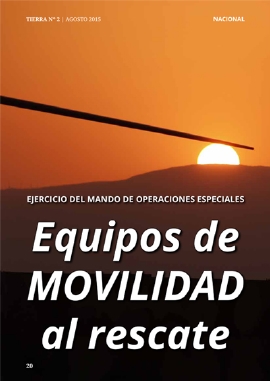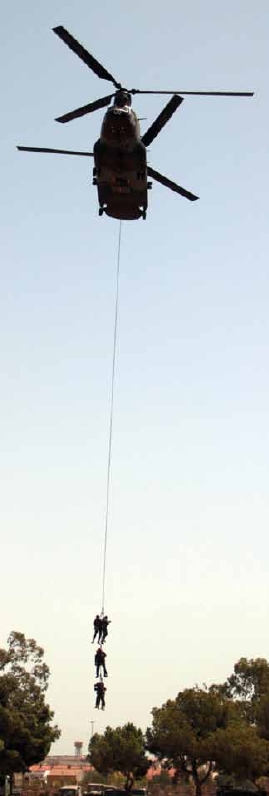- Home
- Feature Articles
- Full article
Mobility Teams to the Rescue
Friday, August 21, 2015
Number: 018
Special Operations Command exercise
Tactical mobility methods play a key role in the exercise led by 19th GOE

Mobility Teams to the Rescue

Mobility Teams to the Rescue

Mobility Teams to the Rescue
Two Spanish citizens have been kidnapped by a terrorist group in a foreign country and a rescue operation is organised to find and free them. This plausible scenario was the theme of this year’s edition of the 'Mobility' exercise, which was planned and directed by the 19th Special Operations Group (GOE by its Spanish acronym) 'Caballero Legionario Maderal Oleaga' and staged in Alicante and Zaragoza in early July.
The exercise brought together teams of mobility specialists from the Special Operations Command (SOC) and was aimed at improving their readiness in this aspect of combat as well as promoting the exchange of experiences and mutual knowledge with other units from the Army and from other countries.
A team from the 1st Infantry Parachute Regiment of the French Navy joined the 11th GOE and 4th GOE teams to undertake the rescue operation, which also involved a section of the 11th Light Armoured Cavalry Regiment 'España', an Explosive Devices Search & Positioning Team of the 1st Engineers Regiment and a Tactical Subgroup of the Army Helicopter Force made up of two Tigers, two Super Pumas and two Chinooks.
Transported by helicopter
The operation teams were transported by helicopter from the 'Alférez Rojas Navarrete' cantonment, in Alicante, to the 'San Gregorio' training centre (CENAD by its Spanish acronym), in Zaragoza. They stopped over at a refuelling and rearming point in the countryside around 80 kilometres from their destiny. The refuelling took place during the night, therefore the participants had to resort to night vision devices, and the operation took place in a tactical environment. The Advanced Reconnaissance Team watching the area, composed of personnel from 4th GOE, provided security and cover.
Once the refuelling was complete the helicopters continued their way to the meeting point, set at 'San Gregorio'. Then the primary action team left the training centre for the combat area in the town of Casas Altas, where the hostages were being held. This had been confirmed by a special reconnaissance patrol which had been inserted three days before and had been watching the target.
The French team afforded cover to the primary action team from the risk of conventional forces on the ground. That team is equipped for that purpose with two tools smaller units do not normally have at their disposal: the MILAN anti-tank missile and training in close combat.
The presence of a conventional enemy next to the asymmetrical enemy – both of which were played by members of the CENAD’s Opposing Force – was one of the novelties of this year’s 'Mobility' exercise. 'The scenario included a hybrid threat, more in line with the missions we are currently having to tackle,' explained the operations officer of 19th GOE.
Despite the involvement of the French team the enemy was able to get away, which demanded the intervention of the Cavalry section. The latter was positioned to engage in combat and was rapidly able to locate and eliminate the enemy.
When that mission was over the teams ran back to the helicopters at the agreed location and, after a new stopover for refuelling, they were back at SOC in Alicante. The main Command Post of the exercise had been deployed there, while two forward operating bases had been set up at 'San Gregorio'' for a closer monitoring of developments.
Road movements
In addition to the air transport manoeuvres which have characterised the 'Mobility'' exercise this year, it also included the customary and essential training in the use of VAMTACs (High Mobility Tactical Vehicles by its Spanish acronym). They were used to undertake special operations incursions and approach manoeuvres. The vehicles involved in the operation followed a three-day tactical itinerary along secondary and rural roads, moving mainly during the night and facing all kinds of incidents, from ambushes to IEDs and targets of opportunity.
In water, too
As well as the Special Operations Force deployed in Zaragoza, a second one was established in Alicante to execute a different set of tasks. The first was to identify and neutralise the terrorist leader, who had been located in an uninhabited area between Villajoyosa and Benidorm.
The best way to access the area was by sea, so an amphibious team of 19th GOE was charged with a helocasting infiltration – a technique which involves dropping an operations team and their boat from a helicopter into the water. The jump took place opposite Cape Huertas, around three miles off the coast, and the personnel used their semi-rigid inflatable boat to reach the shore. When they arrived near the beach a group of divers surveyed it to make sure that it was safe for the team to go ashore.
The next night precision shooters were able to rapidly take positions thanks to their teammates’ previous reconnaissance work and got ready to carry out their mission.
Once it had been fulfilled, another section of the team waiting nearby moved in to free the kidnapped VIP.
'We have dropped backpacks, rifles, boats, etc. from the helicopters. It has been a very useful exercise,' explained the captain leading the amphibious team. The aim was to be trained in the different methods of tactical mobility and the members of MOE have certainly seized the opportunity.
ARMY UNITS
- Araba Álava |
- Albacete |
- Alicante |
- Almería |
- Asturias |
- Ávila |
- Badajoz |
- Barcelona |
- Burgos |
- Cáceres |
- Cádiz |
- Cantabria |
- Castellón |
- Ceuta |
- Ciudad Real |
- Córdoba |
- A Coruña |
- Cuenca |
- Girona |
- Granada |
- Guadalajara |
- Gipuzkoa |
- Huelva |
- Huesca |
- Islas Baleares |
- Jaén |
- León |
- Lleida |
- Lugo |
- Madrid |
- Málaga |
- Melilla |
- Murcia |
- Navarra |
- Ourense |
- Palencia |
- Las Palmas |
- Pontevedra |
- La Rioja |
- Salamanca |
- Segovia |
- Sevilla |
- Soria |
- Tarragona |
- Santa Cruz de Tenerife |
- Teruel |
- Toledo |
- Valencia |
- Valladolid |
- Bizkaia |
- Zamora |
- Zaragoza



